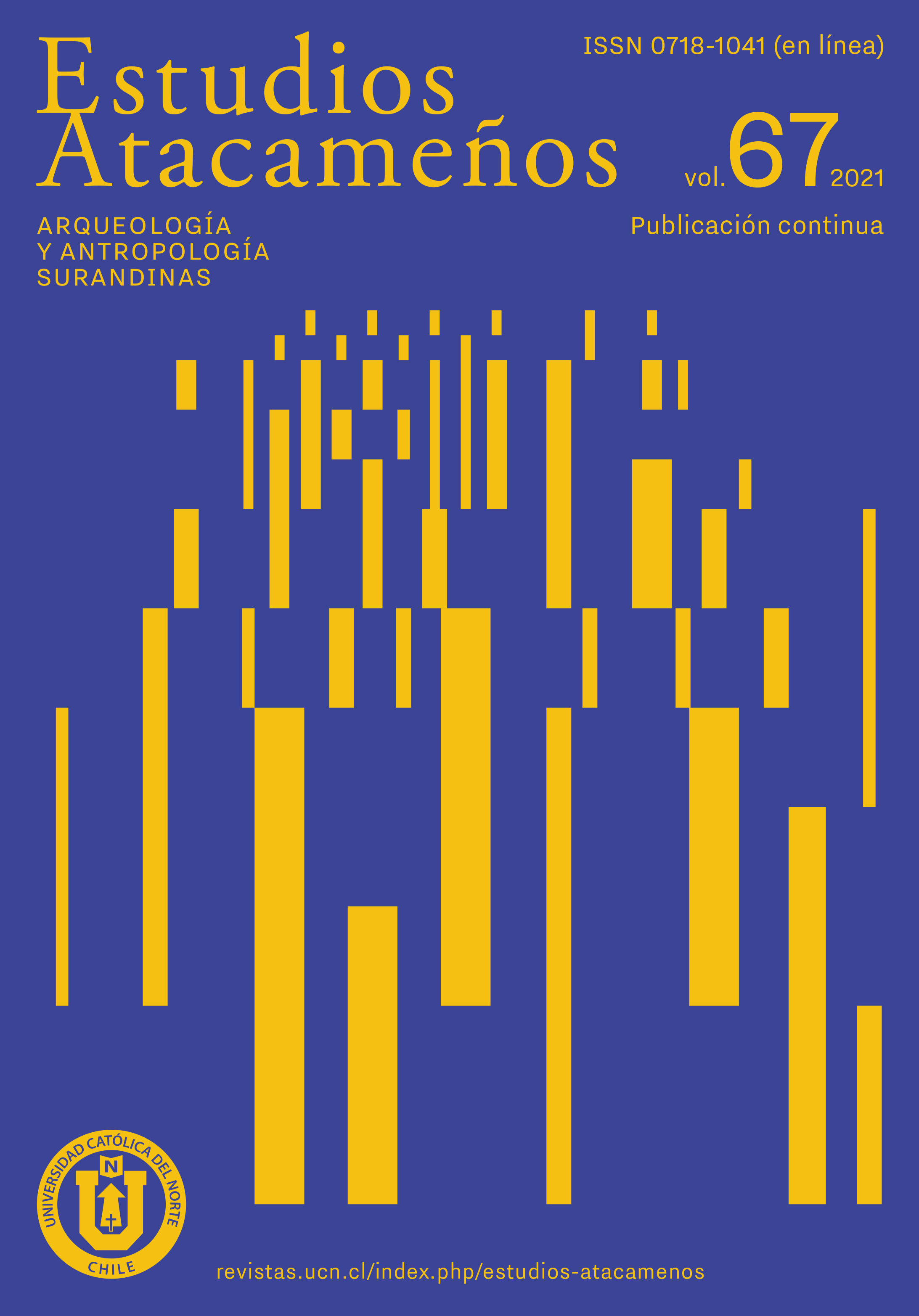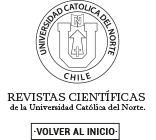Phytolith analysis of the El Pilchao archaeological site sedimentary sequence (Northwest Argentina)
Environmental and anthropic changes during the Upper Holocene
DOI:
https://doi.org/10.22199/issn.0718-1043-2021-0026Keywords:
land use, Regional, Development, microfossilsAbstract
The results of the description of phytoliths recovered from pedosedimentary sequences located in the town of El Pichao (Valle de Santa María, Tucumán, Argentina) belonging to the period of Regional Developments (ca. 1000 - 600 AP) are disclosed. Phytoliths were extracted from the sediment by physical and chemical processing of the samples. The set of phytoliths found allowed the evolution of environmental conditions to be established, leaving evidence of a cold period of arid tendency prior to the establishment of human occupations in El Pichao. During the period of occupation (Regional Developments) the environmental conditions were warmer and more arid than the current ones. Even so, the land was conditioned for its agricultural exploitation, probably with the application of irrigation practices. The presence of phytoliths in the form of a cross (related to maideas) in the middle section of all the agricultural terraces studied appears together with the increase in the number of diatoms, which would indicate that they could have been cultivated intentionally.
Downloads
References
Aagesen, L., Szumik, C. A., Zuloaga, F. O. y Morrone, O. (2009). Quantitative biogeography in the South America highlands - recognizing the Altoandina, Puna and Prepuna through the study of Poaceae. Cladistics, 25, 295-310. http://dx.doi.org/10.1111/j.1096-0031.2009.00248.x.
Bertoldi de Pomar, H. (1971). Ensayo de clasificación morfológica de los silicofitolitos. Ameghiniana, 8, 317-328.
Borrelli, F., Osterrieth M. y Marcovecchio. J. (2008). Interrelations of vegetal cover, silicophytolith content and pedogenesis of Typical Argiudolls of the Pampean Plain, Argentina. Catena 75, 146-153. https://doi.org/10.1016/j.catena.2008.05.001.
Cano, S. F. (2011). Utilización de Recursos Vegetales y Subsistencia en el Valle de Santa María durante el Período de Desarrollos Regionales: Un Caso de Estudio en el Sitio El Pichao (S Tuc Tav 5). Tesis de grado para optar al título de Arqueólogo. Facultad de Ciencias Naturales e Instituto Miguel Lillo, Universidad Nacional de Tucumán, Tucumán, Argentina.
Diamond, J. (2002). Evolution, consequences and future of plant and animal domestication. Nature, 418(8), 34- 41.
Fernández Distel, A., Cámara Hernández, J. y Miante Alzogaray, A. M. (1995). Estudio del maíz arqueológico de Huachichocana II, Provincia de Jujuy, Noroeste de la Argentina. Relaciones de la Sociedad Argentina de Antropología, 20, 189- 204.
Fernández Honaine, M., Oterrieth, M. L. y Zucol, A. F. (2009). Plant communities and soil phytolith assemblages relationship in native grasslands from southeastern Buenos Aires province, Argentina. Catena, 76(1), 89-96.
Gallego, L., Distel, A. R., Camina, R. y Rodríguez Iglesias, R. M. (2004). Soil phytoliths as evidence for species replacement in grazedrangelands of central Argentina. Ecography, 27, 1-8.
Hammer, O., Harper, D. A. T. y Ryan, P. D. (2007). PAST - PAlaeontological STatistics, 75, 86 pp. http://folk.uio.no/ohammer/past.
IPCNWG (2019). International Code for Phytolith Nomenclature 1.0. Annals of Botany, 96(2), 253-260; doi:10.1093/aob/mci172.
Iriarte, J. y Paz, E. A. (2009). Phytolith analysis of selected native plants and modern soils from southeastern Uruguay and its implications for paleoenvironmental and archeological reconstruction. Quaternary International, 193(1), 33-123. http://10.1016/j.quaint.2007.10.008.
Kaplan, L., Smith, M. B. y Sneddon, L. A. (1992). Cereal grain phytoliths of Southwest Asia and. Europe. En Rapp, G. Jr. y S.C. Mulholland, S. C. (Eds.). Phytolith Systematics. Emerging Issues. Advances in Archaeological and Museum Science, 1, 149-174.
Kondo, R., Childs, C., Atkinson, I. (1994). Opal phytoliths of New Zealand. Maanaki Whenua Press, 85.
Korstanje, M. A. (2009). Microfósiles y Agricultura Prehispánica: Primeros resultados de un análisis multiple en el NOA. En Zucol, A. F., Osterrieth, M., Brea, M. y Borrelli, N. (Eds.). Fitolitos: Estado actual de su conocimiento en América de Sur. Universidad Nacional de Mar del Plata.
Korstanje, M. A. y Cuenya, P. (2008). Microfósiles y agricultura prehispánica: Primeros resultados de un análisis múltiple en el Noroeste Argentino. En Zucol, A. F., Osterrieth, M. y Brea, M. (Eds.). Fitolitos: Estado actual de su conocimiento en América del Sur. Universidad Nacional de Mar del Plata.
Korstanje, M. A., Cuenya, P. y Maloberti, M. (2014). El análisis múltiple de microfósiles como herramienta para estudiar paisajes agrícolas y prácticas campesinas: Una síntesis metodológica. En Belmar, C. y Lema, V. (Eds.). Avances y desafíos metodológicos en Arqueobotánica: Miradas consensuadas y diálogos compartidos desde Sudamérica (pp. 252-275). Santiago de Chile: Universidad SEK.
Kulemeyer, J., Lupo, L., Madozzo Jaén, M. C., Cruz, A., Cuenya, P., Maloberti, M., Cortés, G. y Korstanje, A. (2013). Desarrollo del Paisaje Holoceno en la Cuenca de El Bolsón: gente y ambiente en procesos de cambio y estabilidad. Diálogo Andino, 41, 25-44. http://dx.doi.org/10.4067/S0719-26812013000100003.
Lanzelotti, S. L. y Zucol A. F. (2019). Cercanía espacial y distancia temporal entre una unidad doméstica y las estructuras agrícolas adyacentes en el valle de Yocavil. Relaciones Antropológicas, 20(1), 137-152. http://dx.doi.org/10.3906/bot-1312-72.
Lefebvre, M. G., Colobig, M. M., Zucol, A. F., Maldonado, M. G., Sampietro Vattuone, M. M. (2020). Análisis fitolítico del sitio arqueológico Yasyamayo (Santa María - Tucumán - Argentina): Procesos antrópicos y paleoambientales. Chungara. Revista de Antropología Chilena, (52)1, 93-111. http://dx.doi.org/10.4067/S0717-73562020005000203.
Lefebvre, M. G., Colobig, M. M., Zucol, A. F., Maldonado, M. G., Sampietro Vattuone, M. M. (2020). Análisis fitolítico de secuencias pedosedimentarias presentes en la localidad de Molle Yaco (Santa María-Tucumán-Argentina): agricultura prehispánica y paleoambiente. Comechingonia. Revista de Arqueología, 24(2), 77-103. https://doi.org/10.37603/2250.7728.v24.n2.28716.
Maldonado, M. G. (2016). Cambios en la Apropiación del Espacio durante el Período Agroalfarero Prehispánico en la Vertiente Oriental de la Sierra de Quilmes (Tucumán, Argentina). Tesis de Doctorado. Facultad de Ciencias Naturales y Museo, Universidad Nacional de La Plata, Argentina.
Maloberti, M. (2014). Prácticas campesinas en emplazamientos agrícolas formativos: El caso del Alto Juan Pablo (Belén, Catamarca). Comechingonia, 18(1), 139-159. https://doi.org/10.37603/2250.7728.v18.n1.27630
Matsutani, A. (1972). Spodographic analysis of ash from the Kotosh site: A preliminary report. En Izum, S. y Terada, K. (Eds.). Andes 4: Excavations at Kotosh, Peru, 1963 and 1966 (pp. 319- 326). Tokyo: University of Tokyo Press.
Nalepka, D. y Walanus, A. (2003). Data processing in pollen analysis. Acta Paleobotanica, 43(1), 125-134.
Patterer, N. I., Passeggi, E., Zucol, A. F. (2011). Análisis fitolíticos de suelos del sudoeste de la Provincia de Entre Ríos (Argentina) como una herramienta para comprender sus procesos pedológicos. Revista Mexicana de Ciencias Geológicas, 28(1), 32-146.
Pearsall, D. M. (1987). Evidence for prehistoric maize cultivation on raised fields at Peñon del Río, Guayas, Ecuador. En Pre-Hispanic Agricultural Fields in the Andean Region (Part 2), 279-296. BAR International Series 359.
Pearsall, D. M. (2000). Paleoethnobotany: A handbook of procedures. San Diego, CA: Academic Press.
Pearsall, D. M. (2008). Plant Domestication and the Shift to Agriculture in the Andes. En Silverman, H. e Isbell, W. (Eds.). The Handbook of South American Archaeology (pp. 105-120). Nueva York, NY: Springer.
Peel, M. C., Finlayson, B. L. y Mcmahon, T. A. (2007). Updated world map of the Köppen-Geiger climate classification. Hydrology and Earth System Sciences Discussions. European Geosciences, 11(5), 1633-1644.
Peña Monné, J. L., Sampietro Vattuone, M. M., Maldonado, M. G., Cano, S. F. y Aguirre, M. G. (2016). Contexto geomorfológico y problemas de conservación en el sitio arqueológico El Pichao (valle de Santa María, Noroeste Argentino). En Sampietro Vattuone, M. M. y Peña Monné, J. L. (Eds.). Geoarqueología de los Valles Calchaquíes (pp. 165-184). Tucumán: Laboratorio de Geoarqueología, Universidad Nacional de Tucumán.
Peña Monné, J. L., Sancho Marcén, C., Sampietro Vattuone, M. M., Rivelli, F., Rhodes, E. J., Osácar Soriano, M. C. y García Giménez, R. (2015). Geomorphological study of the Cafayate dune field (Northwest Argentina) during the last millennium. Palaeogeography, Palaeoclimatology, Palaeoecology, 438, 352-363. https://doi.org/10.1016/j.palaeo.2015.08.028.
Piperno, D. R. (1984). A comparison and differentiation of phytoliths from maize and wild grasses: use of morphological criteria. American Antiquity, 49, 361-83. https://doi.org/10.2307/280024
Piperno, D. R. y Pearsall, D. M. (1998). The origins of agriculture in the Lowland Neotropics. San Diego, CA: Academic Press.
Piperno, D. y Stothert, K. E. (2003). Phytolith Evidence for Early Holocene Cucurbita Domestication in Southwest Ecuador. Science, 14, 1054-1057.
Planella, M. T., Falabella, F., Belmar, C. y Quiroz, L. (2014). Huertos, chacras y sementeras. Plantas cultivadas y su participación en los desarrollos culturales de Chile central. Revista Española de Antropología Americana, 44(2), 495-522. https://doi.org/10.5209/rev_REAA.2014.v44.n2.50727
Rovner, I. (1971). Potential of opal phytoliths for use in paleoecological reconstruction. Quaternary Research, 1, 345-359.
Sampietro Vattuone, M. M. y Peña Monné, J. L. (2016). Geomorphological dynamic changes during the Holocene through ephemeral stream analyses from Northwest Argentina. Catena, 147, 663-677. https://doi.org/10.1016/j.catena.2016.08.029.
Sampietro Vattuone, M. M. y Peña Monné, J. L. (2019). Geomorphology of Tafí valley (Tucumán Province, Northwest Argentina). Journal of Maps, 15(2), 177-184. https://doi.org/10.1080/17445647.2019.1567403.
Sampietro Vattuone, M. M., Peña Monné, J. L., Maldonado, M. G., Marcén, C. S., Báez, W. A., Sola, A. M. y Blasi, A. M. (2018a). Cambios ambientales durante el Holoceno superior registrados en secuencias morfosedimentarias fluvio-eólicas del Valle de Santa María (Noroeste Argentino). Boletín Geológico y Minero, 129(4), 647-669. https://doi.org/10.21701/bolgeomin.129.4.004.
Sampietro Vattuone, M., Peña Monné, J. L., Roldán, J., Maldonado, M., Lefebvre, M. y Vattuone, M. (2018). Human driven geomorphological processes and soil degradation in Northwest Argentina: A geoarchaeological view. Land Degradation & Development, 29(11), 3852-3865. https://doi.org/10.1002/ldr.3128.
Sayago, J. M., Neder, L. del V. y Puchulu, M. E. (1998). Suelos. En Gianfrancisco, M., Puchulu, M. E., Durango de Cabrera, J. y Aceñolaza, F. G. (Eds.). Geología de Tucumán (pp. 275-284). Tucumán: Colegio de Graduados de Ciencias Geológicas de Tucumán.
Stenborg, P. (2002). Holding Back History – Issues of Resistance and Transformation in a Post-Contact Setting, Tucumán, Argentina c. A.D. 1536-1660. Tesis Doctoral. Gotarc. Serie B. Arkeologiska Skrifter. Gotemburgo, Suecia.
Stephens, L., Fuller, D., Boivin, L., Rick, T., Gauthier, N., A. Kay, A. … Ellis, E. (2019). Archaeological assessment reveals Earth’s early transformation through land use. Science, 365(6456), 897-902. https://10.1126/science.aax1192.
Twiss, P. C. (1992). Predicted world distribution of C3 and C4 grass phytoliths. En Rapp, G. Jr y Mulholland, S. C. (Eds.). Phytoliths Systematics. Emerging Issues. Advances in Archaelogical and Museum Science, 1, 113-128.
Twist, P. C., Suess, E. y Smith, R. M. (1969). Morphological classification of grass phytoliths: Soil science of America. Proceeding, 33, 109-115.
Williams, V., Korstanje, M. A., Cuenya, P. y Villegas, P. (2010). La Dimensión Social de la Producción Agrícola en un Sector del Valle Calchaquí Medio. En Korstanje, M. A. y Quesada, M. (Eds.). Arqueología de la Agricultura: Casos de Estudio en la Región Andina Argentina (pp. 178-207). Argentina: Magma.
Zucol, A. F. (1996). Microfitolitos de las Poaceae argentinas: I. Microfitolitos foliares de algunas especies del género Stipa (Stipeae: Arundinoideae), de la Provincia de Entre Ríos. Darwiniana, 34, 151-172.
Zucol, A. F., Colobig, M. M. y Figueroa, G. G. (2012). Estudio de microrrestos silíceos en sistemas de aterrazamiento del primer milenio DC en el Valle de Ambato (Andes del sur), Catamarca, Argentina. Intersecciones en Antropología, 13(1), 163-179. https://doi.org/10.37603/2250.7728.v24.n2.28716
Zucol, A. F., Figueroa, G. G. y Colobig, M. M. (2015). Nuevos aportes para la caracterización de terrazas de cultivo del primer milenio d.C. en el valle de Ambato (Andes del Sur, Catamarca, Argentina) mediante el análisis de microrrestos. Relaciones de la Sociedad Argentina de Antropología, 40(2), 425-454. https://doi.org/10.37603/2250.7728.v24.n2.28716.
Zucol, A. F., Passeggi, E., Brea, M., Patterer, N. I., Fernández Pepi, G. y Colobig, M. M. (2010). Phytolith analysis for the patrokaike lake drilling proyect: sample treatment protocols for the pasado microfossil manual. En Corbella, H. y Maidana, N. I. (Eds.). 1ª Reunión Internodos del Proyecto Interdisciplinario Patagonia Austral y 1er Workshop Argentino del Proyecto Potrok Aike MaarLake Sediment Archive Drilling Project (pp. 81-84). Buenos Aires: Proyecto Editorial PIPA.
Downloads
Published
Issue
Section
License
Copyright (c) 2021 Maria Gisela Lefebvre, Maria de los Milagros Colobig, Alejandro Fabian Zucol, Maria Marta Sampietro Vattuone

This work is licensed under a Creative Commons Attribution 4.0 International License.

All works published in Revista Estudios Atacameños (ISSN on line:0718-1043) Revista Estudios Atacameños Creative Commons International 4.0 attribution (CC BY 4.0) licence.
Authors remain the owners of their work and may republish their articles elsewhere without having to request permission, as long as they indicate that the work was originally published in Revista Estudios Atacameños (ISSN on liine:0718-1043).












